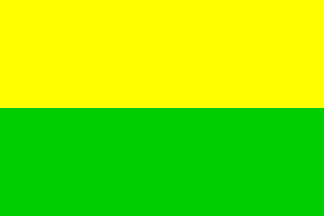
image by Ivan Sache, 30 March 2009

Last modified: 2009-08-15 by dov gutterman
Keywords: education |
Links: FOTW homepage |
search |
disclaimer and copyright |
write us |
mirrors
See Also:
Other Institutions:

image by Ivan Sache, 30 March 2009
"Liceo Tacurí" was founded in 1981 at Cali, by
ASPAEN ("Asociación para la Enseñenza), the organization
set up in Colombia by the Opus Dei movement. The institute is
named after a Quechua word meaning "lively"
The flag of the institute, as shown graphically and described on
the website of
the institute, is horizontally divided blue-white-red.
Blue represents the love for truth.
White represents obedience.
Red represents strength.
Ivan Sache, 30 March 2009
"Unidad Educativa Municipal Instituto Técnico
Industrial" was founded in Fusagasugá, Department of
Cundinamarca, on 27 September 1999 (Decree No. 812), succeeding
different schools founded in the municipality since 1936.
The flag of the institute, as shown graphically and described in
the "institutional
educative project" of the institute, is horizontally
divided blue-white-red, with the emblem of the institute in the
middle (not shown on the drawing but explicitely mentioned in the
text). The flag was designed by the educational community in
1983.
Blue represents the clear working space provided by the institute
White represents tranquillity, peace, calm and serenity required
to think.
Red represents love, friendship and mutual help among the
institute community.
The main elements of the emblem of the institute are described
but their arrangement is not shown.
A book represents science, culture, education and development.
An Olympic torch represents strength.
A square, a hammer and an anvll represent the different technical
skills taught in the institute.
The emblem is bordered by a red stripe charged with the motto of
the institute, "Lealtad, Ciencia y Tecnica" (Loyalty,
Science and Technic).
Ivan Sache, 4 February 2009
"Instituto Técnico Industrial de Tocancipá" was
created on 26 February 1997 (Municipal Decree No. 001) in
Verganzo, Municipality of Tocancipá, Department of Cundinamarca.
Classes started on 18 January 1998. The institute has today for
seats, in Verganzo, La Diana, Canavita and Buenos Aires.
The flag of the institute,
as shown graphically and described on the website
of the institute, is horizontally divided red-gold-grey, with
the emblem of the institute in the middle (omitted on the drawing
but explicitely mentioned in the text). The flag was adopted on
31 October 2003 (Decree No. 005).
Red represents vital energy and torrent of youth, as well as
passion, strength, commitment and permanent sacrifice to learning
and life building.
Gold represents the human potential of the educational community,
as well as its spiritual, social, artistic, technical and
material resources. It is the symbol of power, greatness and
admiration.
Grey represents the metals used in industry, as well as the
strength, work, tenacity and constance of all the members of the
educational community.
The emblem of the institute was modernized in 2008 by Adrián
Eduardo Munar Guarín, Head of the Artistic Education section;
the old emblem is shown but nothing is said on its history and
designer.
The middle of the emblem is made of a grey disk charged with a
white open book and a quill, a calliper rule, a square and a pair
of scales, all in grey. This is similar to the old emblem, except
that the disk was changed from blue to grey to highlight the
technical meaning of the emblem.
A second, concentric white ring is charged with the red letters
"TRABAJO" ("work", top) and
"PROGRESO" ("progress", bottom), highlighting
the commitment to sacrifice of the community.
A third, larger concentric blue ring is charged with
the name of the institute, "INSTITUCION EDUCATIVA
DEPARTAMENTAL" (white) / "TECNICO INDUSTRIAL"
(red) on top, and the name of the place, "TOCANCIPA"
(red) on bottom. In the old emblem, all the writings, including
the aforementioned motto, were in red letters over a wide white
ring. Blue symbolizes knowledge and wisdom.
The outer part of the emblem is made of a grey cogwheel. The
wheel has 16 cogs, while it had 24 of them on the old emblem.
The whole emblem is placed on a square vertically divided
red-blue (red-white on the drawing).
The size and placement of the emblem on the flag remains a matter
of speculation.
Ivan Sache, 2 February 2009

image by Ivan Sache, 10 January 2009
"Colegio Tolimense", a Roman Catholic institute, was
created in 1934 in Ibagué, Department of Tolima, and recognized
on 20 November 1942 by the Ministry of National Education (Decree
No. 1485).
The flag of the institute, as shown graphically and described on
the website
of the institute, is horizontally divided yellow-green.
Yellow represents the spiritual resources while green represents
hope.
Ivan Sache, 10 January 2009

image by Ivan Sache, 19 December 2008
ITFIP (Instituto Tolimense de Formación Técnica
Profesional), located in El Espinal, was recognized by the
Ministry of National Education on 24 December 1980 (Decree No.
3462).
The flag of ITFIP is shown graphically and described on the ITFIP website.
The flag is divided white-blue according to the ascending
diagonal, with the emblem of ITFIP in the middle. Blue represents
democratic identity and collective work. White represents
honesty, transparency and knowledge. The diagonal division
represents action towards an objective.
The emblem of ITFIP is made of a white triangle outlined in
green, charged with two dark red and golden yellow overlapping
human silhouettes, placed on a circular background in the
Colombian national colours (slanted), surrounded by a blue ring
charged with the name of the institute in white capital letters,
surmonting a blue scroll charged with the ITFIP acronym in white
capital letters.
The circular shape represents the emergence of universality as an
institutionalization of the intellect for the conservation and
spread of knowledge.
The triangle represents the highest level of knowledge, as the
merging of the three main aspects of knowledge: teaching,
research and extension. Green represents cooperation, solidarity
and organization. Yellow and golden yellow represent security,
identity and respondability
Dark red represents union, strength and constance.
Ivan Sache, 19 December 2008